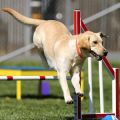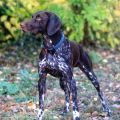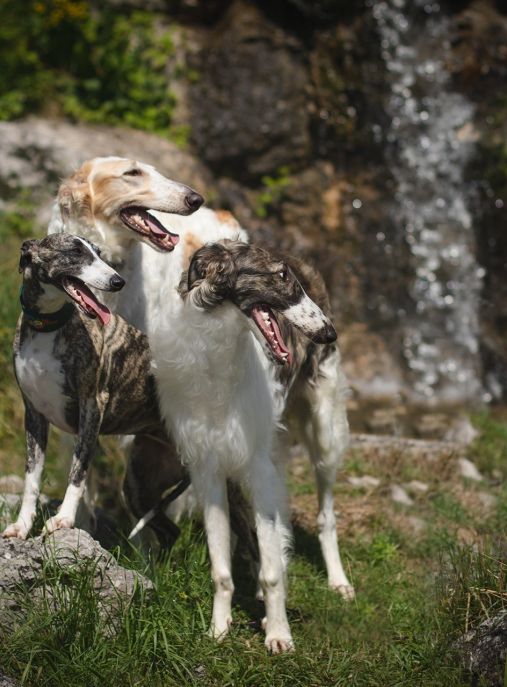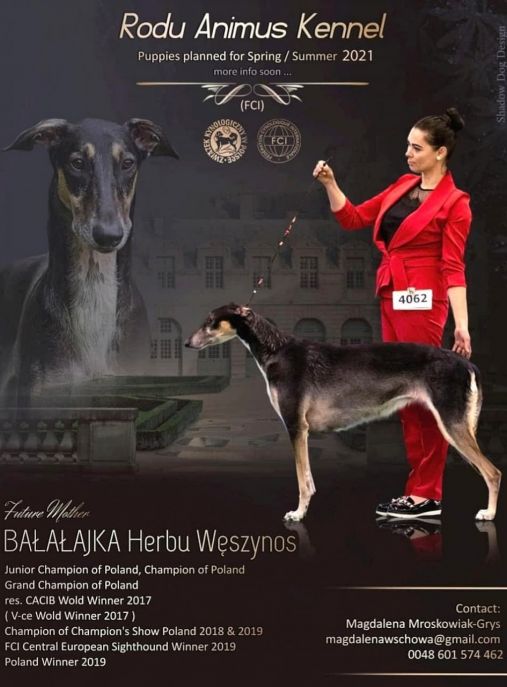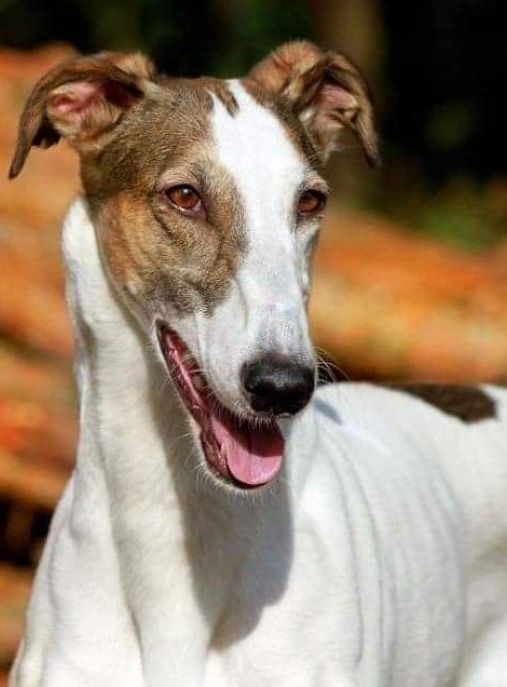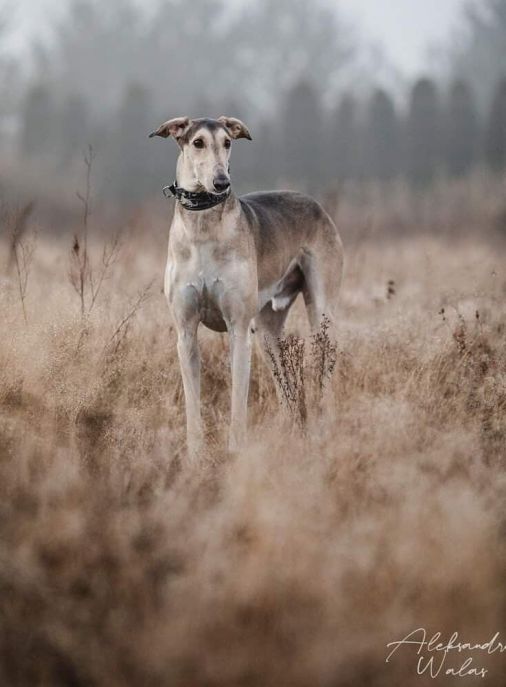The Polish Greyhound, also known as Chart Polski or Polish Sighthound, is a majestic and elegant breed that has captivated dog enthusiasts for centuries. With its slender and athletic build, this breed is renowned for its exceptional speed and agility. The Polish Greyhound is a sighthound, meaning it hunts primarily by sight rather than scent, making it an excellent choice for coursing and racing activities.
Originating in Poland, the history of the Polish Greyhound can be traced back to the 13th century. It is believed that the breed was developed by crossing the Asian sighthounds, brought to Poland by Mongol invaders, with local Polish hunting dogs. Over time, the Polish Greyhound became highly valued by Polish nobility for its hunting prowess and regal appearance.
According to the Fédération Cynologique Internationale (FCI) typology, the Polish Greyhound belongs to Group 10: Sighthounds. This group includes various sighthound breeds that share similar characteristics and hunting abilities. The Polish Greyhound is classified under Section 3: Short-haired Sighthounds.
The Polish Greyhound is a versatile breed that serves multiple purposes. While it excels in coursing and racing, it is also a loyal and affectionate companion. These dogs have a strong prey drive and are best suited for active individuals or families who can provide them with ample exercise and mental stimulation. Due to their sensitive nature, they thrive in a calm and loving environment.
In terms of physical characteristics, the Polish Greyhound is a medium to large-sized breed. Males typically stand between 27 to 31 inches (68 to 78 cm) at the shoulder, while females are slightly smaller, measuring between 26 to 29 inches (66 to 74 cm). The weight of a Polish Greyhound ranges from 60 to 75 pounds (27 to 34 kg). Their lean and muscular bodies are built for speed, allowing them to reach impressive velocities during sprints.
The Polish Greyhound has a short and dense coat that comes in various colors, including black, blue, brindle, fawn, and white. Their coat requires minimal grooming, with occasional brushing to remove loose hair and maintain its shine. This breed is known for its graceful and noble appearance, with a long, narrow head, almond-shaped eyes, and high-set ears that fold backward.
With proper care and a healthy lifestyle, the Polish Greyhound has an average life expectancy of 10 to 12 years. However, it is important to note that individual dogs may vary. Regular exercise, a balanced diet, and routine veterinary check-ups are essential for maintaining their overall well-being.
One interesting fact about the Polish Greyhound is its incredible speed. These dogs can reach speeds of up to 40 to 45 miles per hour (64 to 72 km/h), making them one of the fastest dog breeds in the world. Their slender build, long legs, and flexible spine contribute to their exceptional running abilities.
Despite their impressive athleticism, Polish Greyhounds are generally gentle and affectionate with their families. They form strong bonds with their owners and thrive on human companionship. However, they may be reserved or aloof with strangers, displaying a natural guarding instinct.
In conclusion, the Polish Greyhound is a remarkable breed with a rich history and exceptional physical abilities. Whether as a hunting companion or a beloved family pet, these dogs bring elegance, loyalty, and speed to any household. With their striking appearance and gentle nature, the Polish Greyhound continues to capture the hearts of dog enthusiasts worldwide.
The Polish Greyhound, also known as Chart Polski, is a magnificent breed of dog that possesses a unique character and charm. With their regal appearance and graceful movements, these dogs are a true delight to behold. In addition to their physical beauty, Polish Greyhounds are known for their loyal and affectionate nature, making them wonderful companions for those who appreciate their distinctive qualities.
One of the most striking aspects of the Polish Greyhound's character is their gentle and calm demeanor. They are generally well-mannered and have a natural inclination to be polite and reserved. This breed is known for being incredibly patient, making them an excellent choice for families with children. They are tolerant and gentle, and their calm nature allows them to adapt well to various living environments.
Polish Greyhounds are highly intelligent dogs, which makes them relatively easy to train. They are eager to please their owners and respond well to positive reinforcement techniques. However, it is important to note that they can be sensitive to harsh training methods, so a gentle and patient approach is essential. Consistency and firmness are key when training a Polish Greyhound, as they can be independent thinkers at times.
Due to their strong prey drive, it is crucial to socialize Polish Greyhounds from an early age. They have a natural instinct to chase small animals, so introducing them to different environments and experiences will help them develop appropriate behavior. Early socialization will also help them become more comfortable around strangers and other animals, reducing the likelihood of aggression or fear-based reactions.
Exercise is vital for Polish Greyhounds, as they are an active breed that requires regular physical activity. They have a high energy level and enjoy running and playing. Providing them with ample opportunities to exercise, such as daily walks or runs in a secure area, will help keep them mentally and physically stimulated. It is important to note that Polish Greyhounds have a strong prey drive, so they should always be kept on a leash or in a securely fenced area to prevent them from chasing after small animals.
Despite their active nature, Polish Greyhounds are generally calm and well-behaved indoors. They are known for being clean and have minimal shedding, making them suitable for individuals with allergies. However, they do require regular grooming to maintain their sleek and elegant appearance. Brushing their short coat once or twice a week and trimming their nails regularly is usually sufficient to keep them looking their best.
In conclusion, the Polish Greyhound is a breed that combines beauty, intelligence, and a gentle nature. They are loyal and affectionate companions who thrive in a loving and structured environment. With proper training, socialization, and exercise, Polish Greyhounds can make wonderful additions to any family, providing years of joy and companionship.
The Polish Greyhound, also known as Chart Polski, is a magnificent breed that requires specific care to ensure their well-being and happiness. These elegant and athletic dogs have unique needs that should be met to maintain their health and vitality. Here is an extensive description of the recommended care for Polish Greyhound dogs, along with tips on what to do and what not to do when caring for dogs of this breed.
1. Exercise: Polish Greyhounds are highly active dogs that require regular exercise to stay fit and mentally stimulated. Daily walks, runs, or play sessions in a securely fenced area are essential. However, avoid excessive exercise during their growth phase to prevent joint and bone problems.
2. Diet: Provide a balanced and nutritious diet that meets the specific needs of your Polish Greyhound. High-quality dog food, preferably formulated for large breeds, is recommended. Consult with a veterinarian to determine the appropriate portion sizes and feeding schedule based on your dog's age, weight, and activity level.
3. Grooming: Polish Greyhounds have a short, dense coat that requires minimal grooming. Regular brushing with a soft-bristle brush will help remove loose hair and keep their coat shiny. Bathing should be done only when necessary, using a mild dog shampoo. Pay attention to their nails, ears, and teeth, and maintain proper dental hygiene.
4. Socialization: Early socialization is crucial for Polish Greyhounds to develop into well-rounded and confident dogs. Expose them to various people, animals, and environments from a young age. Enroll them in puppy classes or obedience training to help them learn basic commands and proper behavior.
5. Mental Stimulation: Polish Greyhounds are intelligent dogs that thrive on mental stimulation. Provide them with puzzle toys, interactive games, and training sessions to keep their minds engaged. Mental stimulation helps prevent boredom and destructive behaviors.
6. Health Care: Regular veterinary check-ups are essential to monitor your Polish Greyhound's overall health. Vaccinations, parasite prevention, and routine blood tests should be part of their healthcare regimen. Additionally, be aware of breed-specific health issues such as hip dysplasia, bloat, and heart conditions. Regular exercise, a balanced diet, and maintaining a healthy weight can help prevent some of these issues.
7. Temperature Regulation: Polish Greyhounds have a thin coat and minimal body fat, making them sensitive to extreme temperatures. Protect them from cold weather with appropriate clothing or provide a warm shelter. During hot weather, ensure they have access to shade, fresh water, and avoid exercising them during the hottest parts of the day.
What to do:
- Provide regular exercise and mental stimulation to keep them physically and mentally fit.
- Offer a balanced and nutritious diet suitable for their age and activity level.
- Socialize them from an early age to ensure they are well-adjusted and friendly.
- Schedule regular veterinary check-ups and follow recommended vaccination and preventive care protocols.
- Provide a comfortable and safe environment, including appropriate bedding and shelter.
What not to do:
- Do not over-exercise Polish Greyhounds during their growth phase to avoid potential joint and bone problems.
- Avoid leaving them alone for extended periods as they thrive on companionship.
- Do not neglect their grooming needs, as regular brushing and dental care are essential.
- Avoid exposing them to extreme temperatures without appropriate protection.
- Do not skip regular veterinary check-ups or neglect their healthcare needs.
By following these tips and providing the recommended care, you can ensure that your Polish Greyhound leads a happy, healthy, and fulfilling life. Remember, each dog is unique, so always pay attention to their individual needs and consult with professionals for personalized advice.
The Polish Greyhound, also known as Chart Polski, is a majestic and elegant breed that possesses a unique and striking coat color. The most common color seen in Polish Greyhounds is a beautiful shade of solid gray, which is often referred to as "grey brindle" or "blue brindle."
The coat of a Polish Greyhound is short, dense, and smooth, providing a sleek and streamlined appearance. The gray coloration of their coat is characterized by a mixture of black and white hairs, resulting in a stunning and eye-catching pattern. The intensity of the gray color can vary from dog to dog, with some individuals displaying a lighter shade, while others exhibit a darker and more pronounced hue.
The gray brindle coat of the Polish Greyhound is often described as having a bluish tint, giving it a regal and sophisticated look. The combination of black and white hairs creates a mesmerizing effect, as the colors blend seamlessly together, forming a harmonious and balanced appearance. The brindle pattern is typically seen in a striped or streaked formation, with the gray color dominating the overall coat.
One of the most captivating aspects of the Polish Greyhound's gray coat is its ability to reflect light. When sunlight or artificial light hits their fur, it creates a subtle shimmering effect, enhancing the beauty and allure of their color. This unique feature adds an extra dimension to their appearance, making them even more captivating and visually appealing.
In addition to their stunning gray brindle coat, Polish Greyhounds may also exhibit small patches of white on their chest, paws, or tail tip. These white markings provide a delightful contrast to the gray color, further enhancing their overall aesthetic appeal.
The gray coat of the Polish Greyhound not only contributes to their physical beauty but also serves a practical purpose. This coloration helps them blend into their surroundings, making them excellent hunters and trackers. Their ability to camouflage in various environments allows them to approach their prey with stealth and agility, making them highly efficient and effective in their hunting endeavors.
In conclusion, the common color of Polish Greyhound dogs is a captivating shade of solid gray, often referred to as gray brindle or blue brindle. This unique coat color, characterized by a mixture of black and white hairs, creates a stunning and regal appearance. The gray brindle coat, with its bluish tint and shimmering effect, adds to the breed's elegance and allure. Combined with their sleek and streamlined physique, the Polish Greyhound's gray coat makes them a truly remarkable and visually striking breed.
The Polish Greyhound, also known as Chart Polski, is a magnificent breed known for its elegance, speed, and agility. These dogs have a strong and athletic build, with a lean body and long legs. While they are generally a healthy breed, like any other dog, they are prone to certain health issues that owners should be aware of. In this text, we will explore the most common diseases found in Polish Greyhounds and provide tips on how to care for their overall health.
One of the most prevalent health concerns in Polish Greyhounds is hip dysplasia. This condition occurs when the hip joint doesn't develop properly, leading to discomfort, pain, and eventually arthritis. Regular exercise and maintaining a healthy weight are crucial to prevent or manage hip dysplasia. Additionally, providing a balanced diet rich in essential nutrients, including glucosamine and chondroitin, can help support joint health.
Another common health issue in Polish Greyhounds is bloat, also known as gastric dilatation-volvulus (GDV). This condition occurs when the stomach fills with gas and twists, leading to a life-threatening situation. To minimize the risk of bloat, it is recommended to feed your dog smaller, frequent meals instead of one large meal. Avoid vigorous exercise immediately after meals and ensure your dog has a calm environment during mealtime.
Polish Greyhounds are also prone to heart diseases, including dilated cardiomyopathy (DCM). DCM is a condition that affects the heart's ability to pump blood efficiently, leading to fatigue, coughing, and difficulty breathing. Regular veterinary check-ups, including heart screenings, can help detect any early signs of heart disease. A heart-healthy diet, low in sodium and rich in omega-3 fatty acids, can also support cardiovascular health.
Like many large breeds, Polish Greyhounds are susceptible to certain types of cancer, including osteosarcoma (bone cancer) and lymphoma. While cancer is difficult to prevent, early detection is crucial for successful treatment. Regular veterinary examinations, including thorough physical examinations and screenings, can help identify any potential signs of cancer. Additionally, maintaining a healthy lifestyle, including a balanced diet and regular exercise, can contribute to overall well-being and potentially reduce the risk of cancer.
To ensure the overall health of your Polish Greyhound, it is essential to provide them with regular exercise. These dogs have a high energy level and require daily physical activity to keep them mentally and physically stimulated. Long walks, jogging, or even participating in dog sports like lure coursing can help meet their exercise needs.
Proper nutrition is also vital for the health of Polish Greyhounds. Feeding them a high-quality, balanced diet that meets their specific nutritional requirements is crucial. Consult with your veterinarian to determine the appropriate portion sizes and choose a diet that suits your dog's age, activity level, and any specific health concerns.
Regular veterinary check-ups are essential for early detection and prevention of any potential health issues. Vaccinations, parasite prevention, dental care, and routine blood work are all part of maintaining your Polish Greyhound's well-being.
In conclusion, while Polish Greyhounds are generally a healthy breed, they are prone to certain health issues like hip dysplasia, bloat, heart diseases, and cancer. By providing regular exercise, a balanced diet, and routine veterinary care, you can help ensure the overall health and well-being of your beloved Polish Greyhound.
The Polish Greyhound, also known as Chart Polski, is a magnificent and elegant breed known for its speed, agility, and endurance. To ensure the optimal health and well-being of these dogs, it is crucial to provide them with a well-balanced and nutritious diet. Proper nutrition plays a vital role in maintaining their energy levels, muscle development, and overall health.
When it comes to feeding a Polish Greyhound, it is essential to consider their unique dietary requirements. These dogs are highly active and have a fast metabolism, which means they require a diet rich in high-quality proteins, healthy fats, and complex carbohydrates. Here are some guidelines to follow when feeding a Polish Greyhound:
1. High-Quality Protein: Protein is the building block for muscle development and repair. Ensure that your Polish Greyhound's diet includes lean sources of protein such as chicken, turkey, fish, or beef. Avoid processed meats or those with excessive fat content, as it can lead to weight gain and other health issues.
2. Balanced Diet: Provide a well-balanced diet that includes a mix of proteins, carbohydrates, and fats. Include a variety of fruits, vegetables, and whole grains to provide essential vitamins, minerals, and fiber. This will help support their immune system and promote healthy digestion.
3. Healthy Fats: Include healthy fats in their diet, such as fish oil or flaxseed oil, which are rich in omega-3 fatty acids. These fats are beneficial for their skin and coat health, joint health, and overall inflammation reduction.
4. Portion Control: Polish Greyhounds have a tendency to overeat, so it is crucial to monitor their portion sizes. Divide their daily food intake into two or three smaller meals to prevent bloating or digestive issues. Consult with your veterinarian to determine the appropriate portion size based on your dog's age, weight, and activity level.
5. Hydration: Always ensure that your Polish Greyhound has access to fresh and clean water. These dogs are highly active and can easily become dehydrated, especially during exercise or hot weather. Monitor their water intake and refill their bowl regularly.
6. Avoid Harmful Foods: Some foods can be toxic or harmful to dogs and should be avoided. These include chocolate, caffeine, grapes, raisins, onions, garlic, alcohol, and anything containing xylitol. These foods can cause severe health issues and, in some cases, be fatal.
7. Regular Vet Check-ups: Regular veterinary check-ups are essential to monitor your Polish Greyhound's overall health and nutritional needs. Your vet can provide specific dietary recommendations based on your dog's individual requirements, including any necessary supplements.
Remember, every dog is unique, and their nutritional needs may vary. It is always recommended to consult with a veterinarian or a professional canine nutritionist to develop a personalized diet plan for your Polish Greyhound. By providing a well-balanced and nutritious diet, you can ensure that your Polish Greyhound remains healthy, active, and happy throughout their life.




